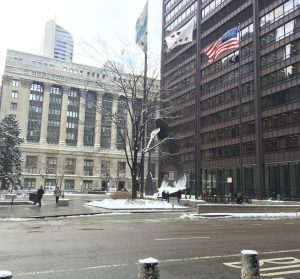For decades, public housing has been an issue across America. “Projects” have been designed under one format: high rise, brown, and cheap looking. This way of thinking and designing is one of the many reasons why these cheap buildings have deteriorated and vanished. But it seems that the Dearborn Homes have finally got the fair and livable environment its residents deserve; the newly decorated, low-rise buildings have transformed from cheap and dreadful to likeable and eye-catching.
Built in the 1950s, just south of The Harold Ickes on South State Street and north of the Illinois Institute of Technology between 27th and 30th Streets, the Dearborn Homes were Chicago’s most diverse and clean public housing buildings.
“The Dearborns were the first projects to have elevators. Everybody else had to walk to stairs to get to their apartments — not us,” said Evelyn Hartmen, a former Dearborn Homes resident. Now, decades later, the Dearborn Homes are the first Chicago public housing project to be rehabbed, according to the Chicago Housing Authority Web site.
The Dearborn Homes, like many that once lined State Street, consist of many low-rise buildings. As of now, three of the 16 Dearborn Homes have been renovated; according to the CHA, the rest will be completed by 2012.
“I remember the Dearborn Homes falling apart in the 1990s, when me and my mother first moved in. They’re real nice now,” said Natasha Isom, 35, a nurse, as she sat in front of her Dearborn home. When asked why she is still a resident in the homes with her salary as a nurse, Isom said, “This is home, it’s affordable, there’s good people here. I’ve built so many relationships and bonds, and mainly because it’s home to me.”
According to the CHA’s Web site, designer Henry Zimoch, a principal at the Chicago architecture firm HPZS, is the mastermind behind the Dearborn Homes’ internal and external remodeling. A fan of Georgian architecture, Zimoch had the simplest approach to the Dearborn Homes that could have saved many other projects: to “work with the existing cross-shaped buildings and dress them up Georgian style.” The previously flat-roofed buildings are now triangle shaped green and white roofs that etch against the sky. New bricks have been placed in the corners of the buildings, and these once dull buildings now have a sense of texture and design.
The newly developed buildings bring hope for many of the residents, and many complaints of their living spaces have now been fixed. But many of the Dearborn Homes are still in bad shape, and some residents will have to wait up to two years before their homes are renovated.
,Many low-income families would love for an opportunity to reside in the Dearborn Homes — especially those who have been forced to leave previous projects — but according to the CHA’s Web site, the apartments are full.
“Only residents who were living in CHA developments as of October 1, 1999, and have remained lease-compliant are eligible to live at this property,” the Web site states. ” The CHA is currently not accepting new applicants at any of its family properties. Eligible CHA relocates should contact their relocation manager for more information.”
“What’s not fair is the Dearborn Homes are getting remodeled, but if you’re not already a resident, you won’t be able to live there once your project is destroyed,” Hartmen said. “I thought the CHA wanted new mixed-income living spaces, but I’m sure the Dearborn Homes will remain black and poor despite the remodeling.”

![Reblog this post [with Zemanta]](http://img.zemanta.com/reblog_c.png?x-id=cd83a772-6e39-46e6-b932-282012d730ca)





Be First to Comment